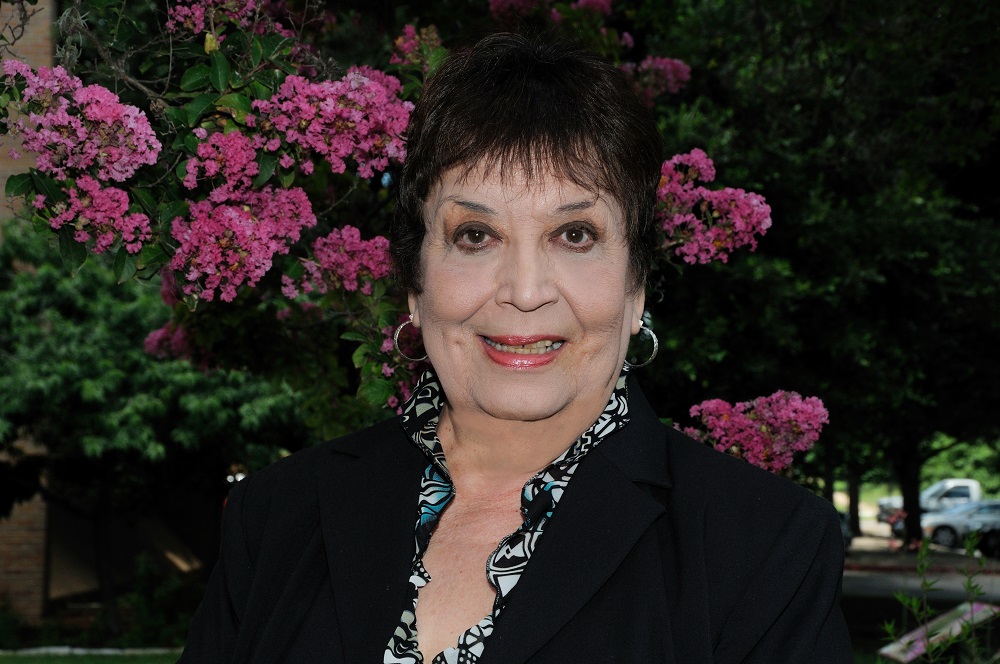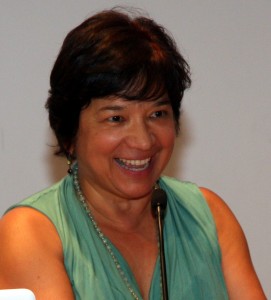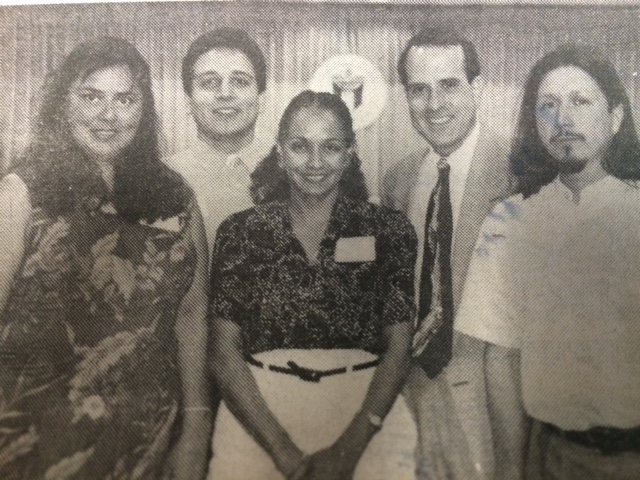Emma S. Barrientos Mexican American Cultural Center (ESB-MACC) Oral History Project
About the Emma S. Barrientos Mexican American Cultural Center
In the early 1970s at the height of the Chicano Movement in Austin, Texas, Mexican American and Latino artists, educators, and leaders recognized a need for cultural arts space, education, and programming. With members from such organizations as the League of United Chicano Artists (LUChA) in East Austin, a myriad of Latino dance arts groups, Chicano theater troupes, and community organizations, this idea gained momentum. The eventual demise of El Centro Chicano and the Juárez-Lincoln Center created an urgent need for a community cultural center, and Austin’s artists and community leaders were eager to pursue that goal. After many long years and struggles, ground broke for the Mexican American Cultural Center (MACC) in 2005, and, at last, the grand opening was held September 15, 2007, realizing a nearly 40 year old dream for the Mexican American community in Austin. In 2011, the center was renamed the Emma S. Barrientos Mexican American Cultural Center (ESB-MACC).
About the Oral History Project
A goal of this oral history project was to document and honor many of the individuals who played a significant role in the decades-long struggle leading to the creation of the Emma S. Barrientos Mexican American Cultural Center (ESB-MACC), while also exploring the growth and obstacles experienced throughout the process. Included in this collection are the preserved oral histories of 28 stakeholders, including transcripts, audio and some video. The archival collection (AR.2015.012) also includes newspaper articles, newsletters, and event flyers.
Link to the full online finding aid is on TARO: http://www.lib.utexas.edu/taro/aushc/00502/ahc-00502.html
Listen to clips of the oral history interviews here:
Gustavo ‘Gus’ Garcia, Interviewed by Paul Saldaña on September 14, 2012. Garcia was born in South Texas and moved to Austin in 1957 to pursue higher education at the University of Texas and eventually became the first Mexican American in Austin to start his own practice as a Certified Public Accountant (CPA). This led him to community organizing and politics; he joined the Human Relations Commission, became the first Mexican American to be elected to the school board, was elected to City Council where he helped to pass an ordinance that designated land to the MACC, and eventually became the first Latino Mayor of Austin in 2001.
Photo: [Gus Garcia], AR.2010.016(334), Mexican American Firsts: Trailblazers of Austin and Travis County Exhibit Collection
Read Gus Garcia's oral history transcript.
Listen to the full interview:
Gloria Mata Pennington, Interviewed by Celia R. Tovar on July 16, 2012. Pennington arrived in Austin in 1965 with her husband, who began his career at Austin’s second television station, KHFI-TV. She started working with the Austin Parks & Recreation department in 1976, where she had her first memories of discussions about a need for a Mexican American Cultural Center. She witnessed the birth of the MACC through every stage of its inception, organized the program for the opening reception for the MACC, which coincided with the annual Diez y Seis celebration in 2007, and was Master of Ceremonies.
Photo: [Gloria Mata Pennington], AR.2010.016(410), Mexican American Firsts: Trailblazers of Austin and Travis County Exhibit Collection
Read Gloria Mata Pennington's oral history transcript.
Listen to the full interview:
Dr. Emilio Zamora, Interviewed by Cassie Smith on August 17, 2012. Zamora was raised mostly in La Feria, Texas, and earned his Bachelor’s and Master’s degrees at Texas A&I in 1969 and 1972, where he became active in the Mexican American student movement. He eventually pursued a multidisciplinary doctoral program in Mexican American Studies at UT with a goal of being able to teach Mexican American History. He taught at Juarez-Lincoln in the mid-1970s. In the late 90’s, he became tied to the MACC through the early productions of La Pastorela, of which he and his daughter were a part of. He eventually joined the MACC Advisory Board. He speaks of events leading up to the development of the MACC and its cultural and political impact now and for the future.
Photo: [Emilio Zamora], AR.2010.016(464), Mexican American Firsts: Trailblazers in Austin and Travis County Exhibit Collection
Read Dr. Zamora's oral history transcript.
Listen to the full interview:
Laura Esparza, Interviewed by Gloria Espitia on October 18, 2012. Esparza was born in 1958 to one of the founding families of San Antonio. She studied community arts development and theater while in college in the Pacific Northwest and eventually moved to Austin to become the Division Manager that oversaw the MACC and several cultural facilities. While she was not intimately involved in the design of the MACC facility, she evolved the dance rehearsal studio into the Black Box Theater, and developed the Latino Arts Residency Program.
Photo: Laura Esparza, Todo Austin, July 13, 2013
Read Laura Esparza's oral history transcript.
Listen to the full interview:
Roén Salinas, Interviewed by Cassie Smith on September 3, 2012. Salinas was raised in East Austin during the Civil Rights era, where his family founded Aztlan Dance Company. He became involved with the arts at Juarez-Lincoln University and, as an artist, spoke on behalf of the need for a cultural center. He worked at the Guadalupe Cultural Arts Center in San Antonio for two years and came back to Austin in time to work on the 1992 bond campaign and then CMACA. He discusses when the City assumed control of the MACC project and the impact that had on the direction of the MACC’s vision and mission.
Photo: Roén Salinas (second from left), Mexic-Arte Community Arts Newsletter, April 1998. Also pictured: Delia Perez Meyer, Sylvia Orozco, Tomas Salas.
Read his oral history transcript.
Listen to the full interview:
To listen to more oral histories and research the project, visit us at the Austin History Center!
Brief Biographies of Participants in the Oral History Project
Raul Alvarez, Interviewed by Rene Renteria on May 31, 2012. Alvarez moved to Austin from the Rio Grande Valley for his graduate work in 1991 and subsequently remained in East Austin, where he became involved in PODER and eventually was elected to the City Council. He discusses early visions and planning of the MACC’s construction, organization and management at 600 River Street.
James "Jaime" Manley Beaman, Interviewed by Cassie Smith on November 1, 2012. Beaman grew up in Brownsville, Texas and lived and worked in Mexico throughout his youth. He moved to Austin to study architecture and eventually opened his own business, CassaBella Architects. He teamed up with Teodoro González de León and Martina Campo and was hired by a firm in San Francisco to be the architect team for the MACC.
Mary Lou Castillo, Interviewed by Cassie Smith on August 22, 2010. Castillo grew up in Lampasas, Texas in the 1960s and became a permanent resident of Austin in 1994. She worked in education and healthcare and was active in the arts. Castillo co-founded LUPE Arte, a community Latina/o arts organization, and produced La Pastorela and art programs at the MACC.
Perla Cavazos, Interviewed by Stacey Wilson on July 16, 2012. Cavazos was born in San Benito, Texas in 1975 and moved to Austin in 1997 to pursue a fellowship with the National Council of La Raza. She became involved with Latina/o arts in Austin, La Pastorela at the MACC and the Aztlan Dance Company in East Austin; she was active in the MACC bond campaign and the early planning stages of the new space for the MACC in 1998.
Maria Luisa “LuLu” Flores, Interviewed by Stacey Wilson on July 18, 2012. Flores was born in Laredo, Texas in 1955 and moved to Austin to pursue a degree at the University of Texas, where she eventually earned her law degree in 1980. She was involved with Latino arts and dance, which put her in touch with early planning initiatives for the MACC, including the 1992 bond election. She also served on the Board of Directors for the Mexic-Arte Museum for almost 10 years.
Bobbie Garza-Hernandez, formerly Bobbie Enriques, Interviewed by Perla Cavazos on June 30, 2012. Garza-Hernandez moved to Austin from San Marcos, Texas in 1972 where she worked for Region 13 Education Service Center, alongside Juan Pablo Gutierrez, to whom many attribute to birthing the concept of having a Mexican American Cultural Center. She worked for Gus Garcia in the 1990s and helped raise funding for the building of the MACC.
Frances Bazan Martinez, Interviewed by Gloria Espitia on October 15, 2012. Martinez was born in 1942 in Austin and remained in East Austin, where she helped organize early East Austin Latino neighborhood coalition El Concilio de East Town Lake Citizens at El Centro Chicano, then the Quintanilla “Q” House, then at Juarez-Lincoln University. She was involved in initial stages of advocating for a Mexican American community center to be built at Fiesta Gardens in 1986.
Mike Martinez, Interviewed by Gloria Mata Pennington on October 1, 2012. Martinez was raised in Caldwell, Texas, moved to Austin to attend college, and eventually started working for the fire department. He became active in the Hispanic Firefighters’ Union in the early 1990s, which held events at the first facility on River Street that served as the Mexican American center. He soon thereafter ran for and was elected to City Council, where he had a hand in the re-naming of the MACC after Emma S. Barrientos. He discusses the future plans and subsequent phases for the MACC.
Valerie Monique Menard, Interviewed by Gloria Espitia on September 18, 2012. Menard was born in Glendale, CA in 1962 and raised in San Antonio, Texas. She relocated to Austin to study Journalism at the University of Texas, where her first job was with Cathy Vasquez-Revilla at La Prensa in 1989. Her involvement with CMACA and then the MACC came when she was appointed to the City Arts Commission and subsequently the MACC task force in 1998. She serves as President for CMACA.
Delia Perez-Meyer, Interviewed by Gloria Espitia on October 16, 2012. Perez-Meyer was born in Fort Worth, TX in 1957 and raised in East Austin with a strong background in music, performance, and art. She first became involved with the MACC project in the 1970s through the initial organizing for a community space, and was active in the development of CMACA and the eventual negotiation of land for the MACC.
Sylvia Orozco, Interviewed by Margot Millard on July 28, 2012. Orozco moved to Austin in 1975 to attend the University of Texas to study Art; she joined Raza Unida, MAYO, and the Chicano Art Student Association (CASA), where she lent her artistic hand in designing posters and flyers and organizing exhibitions. While studying in Mexico on a scholarship, she helped coordinate a conference that brought Mexican artists and muralists to UT, which coincided with the movement in Austin for Mexican American cultural services and, ultimately, the MACC. She founded the Mexic-Arte Museum in 1983 and discusses the collaboration between Mexic-Arte and the MACC.
Juan Oyervides, Interviewed by Cassie Smith on October 6, 2012. Oyervides was born and raised in Fort Stockton, Texas, studied Microbiology at Texas Tech, and started working at the Texas Department of Health in Austin. He eventually pursued his MBA at UT in 1995 and was offered a position with the Hispanic Chamber of Commerce, putting him in touch with many local Mexican American leaders and business owners. This led to a paid position as manager of CMACA to provide guidance and structure, and after the MACC was established, he was appointed to the MACC advisory board.
Catherine Vasquez Revilla, Interviewed by Susana Almanza on August 26, 2012. Vasquez Revilla was born in East Austin, where generations of her family had lived since 1913. She went to UT where she was trained in Bilingual Education; she left teaching to run her own newspaper, La Prensa, in 1986. She was appointed to the City Council Planning Commission in 1991 and was the Chair of the MACC Task Force, which succeeded in getting it on the bond election in 1992. She remains actively involved with CMACA as Vice President.
Gilbert Cortez Rivera and Jane Haney Rivera, Interviewed by Luis Acuña on July 30, 2012. Jane and Gilbert Rivera are lifelong East Austin community members and activists who speak on history, culture, race, class and gentrification in East Austin. Gilbert organized with the Brown Berets in the early 1970s before he went to the University of Washington for college. He became involved with the MACC upon his return to Austin in the 1980s. Jane is the Chair for the City of Austin Parks and Recreation Board and co-wrote a book with her husband about the historical Rosewood neighborhood in East Austin. They discuss their experiences with the MACC and offer critiques and insight into its development and future.
Donato Rodriguez III, Interviewed by Gloria Espitia on October 15, 2012. Rodriguez moved to Austin from Del Rio, Texas, in 1972 to attend the University of Texas. His parents were both instrumental in Austin education, and his dad was the State Director of the Equal Education Opportunity Division and worked tirelessly on desegregation. He worked with the Juarez-Lincoln Institution in the late 70s and with the City of Austin since 1982, primarily with the Civil Rights Division. He became directly involved with the MACC around 2000 as a member of the CMACA board and eventually as the Chair of the Advisory Committee for the MACC.
Zeke Romo, Interviewed by Susana Almanza on July 30, 2012. Romo’s family moved to Austin from Kyle, Texas in 1960 in order to find work after the cotton pickers were introduced to the fields. He studied Journalism at UT and began covering East Austin events and news for the The Daily Texan and The Echo. He was involved in early discussion of a Mexican American cultural center, particularly near Fiesta Gardens. He worked for East Austin Chicano Development Corporation and conducted a survey assessing whether citizens felt a need for a Mexican American cultural center.
Velia Sanchez-Ruiz, Interviewed by Cassie Smith on October 19, 2011. Sanchez-Ruiz moved to Austin in the mid-1960s in the Civil Rights era to become the second Latina teaching at Becker Elementary School in South Austin. She and Emma Barrientos met during this time and supported their husbands and friends in their union organizing around the Economy Furniture Strike. They organized a summer dance recital for young children at Becker with regional Mexican dances, which demonstrated a need for a cultural center with performance space. She eventually was nominated to be on the advisory board for the MACC.
Tomás Salas, Interviewed by Rene Renteria on July 30, 2012. Salas moved to South Austin in high school and started the first Mexican-American student group at Travis High School. He became involved in the creation of the MACC in the 1980s through his participation in the Brown Berets and LUChA. He, along with Juan Pablo Gutierrez, started a theater company in a rented space called the Museo del Barrio. He moved away to perform with El Teatro Campesino but returned to Austin in the mid-90s, reviving the MACC Task Force and developing CMACA, where he was the site manager for the warehouse prior to the MACC building.
Marcelo Tafoya, Interviewed by Gloria Espitia on August 2, 2012. Tafoya was raised in Georgetown, Texas and in 1962, he bought air time at a radio station in an effort to serve his community. He became a program director at KEZZ in Austin, had a two hour Spanish program at KUT, and a TV show called Austin Presenta. He was active in the Brown Berets, and when he started his newspaper, The Echo, he gave the Brown Berets portable cameras to take photos of police brutality in East Austin. His less radical paper, Musica, funded the Echo for years.
Modesta Treviño, Interviewed by Lori Cervenak Renteria on June 7, 2012. Treviño was born and raised in Austin in Chalmers Projects and was a teacher for 27 years in East Austin. She got a scholarship to attend St. Edward’s University, became a member of Mujeres Artistas del Suroeste (MAS), LUChA, and Raza Unida and collaborated with Sylvia Orozco to organize an art conference bringing artists from around the country and Latin America to Austin. She speaks about the impact of the MACC from the perspective of a radical local artist.
Raul Valdez, Interviewed by Esther Diaz Martin on August 26, 2012. Valdez received his Bachelor’s in Fine Art from Texas A&I and moved to Austin in 1975 for graduate school. He volunteered his time with the Brown Berets at El Centro Chicano in East Austin and was a founding member of LUChA. He started painting murals, including the famous mural of “Los Elementos” on the Juarez-Lincoln building, for which he received an “F” in his Fine Arts graduate program at UT.
Herlinda Zamora, Interviewed by Cassie Smith on July 18, 2012. Zamora was born in 1966 in Eagle Pass, Texas, grew up in Wisconsin, and moved to Austin to pursue her passion of Latin American Art. She worked with the Mexic-Arte Museum for eleven years, including as the acting director for a year; eventually she earned a position as the Cultural and Arts Manager of the ESB-MACC. She speaks from a leadership role within the MACC about its positive contributions as a functioning cultural center for the Mexican American community in Austin and on a national scale, as well.
Clemencia Zapata, Interviewed by Cassie Smith on August 7, 2012. Zapata was born in San Antonio, Texas, raised in Milwaukee, WI, and moved to Austin in 1985. She was a founding member of ALLGO, which stood for the Austin Latino Lesbian & Gay Organization at the time. She became involved with CMACA and the MACC through playing music for La Pastorela and was on the advisory board for the 1998 bond election. She discusses some of the internal struggles community members faced in the development of the MACC.
![[Gus Garcia], AR.2010.016, Mexican American Firsts: Trailblazers of Austin and Travis County Exhibit Collection](/library/u8043/gus_garcia_resized.jpg)



